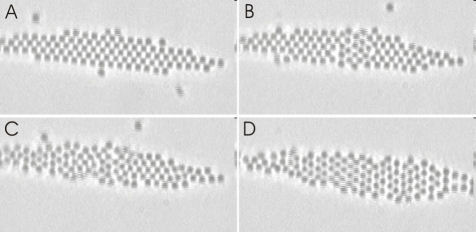Optical Trapping
Research Topics: Optical Trapping
Ordered arrays of particles can be formed with OPTICAL TWEEZERS containing a large number of intensity maxima in the focal plane of the laser. We are interested in a different type of array that forms spontaneously in a laser beam due to the much less-studied phenomenon of optical binding. In optical binding, the formation of the array is not imposed by the optical field of the laser, but arises from multiple scattering of the incident laser beam by the particles themselves. We use an evanescent wave to confine the region of interaction between a laser and a suspension of latex spheres to a thin layer near a surface. Particles with a diameter around 500 nm spontaneously assemble into a variety of different two-dimensional arrays with rectangular, hexagonal or more complicated packing.[1,2] These arrays display features of atomic solids, such as twinning defects, vacancy diffusion, Ostwald ripening and phase transitions. A theoretical model to explain the experimental observations is being sought.
The New Scientist magazine (May 13, 2006) carries a feature article ‘The Stuff of Beams’ highlighting our work on particle arrays bound by light – described as the ‘world’s most unlikely construction material’.


References
1. C. D. Mellor and C. D. Bain “Array Formation in Evanescent Waves” ChemPhysChem 2006, 7, 329-332 (DOI).
2. C. D. Mellor, C. D. Bain and J. Lekner “Pattern Formation in Evanescent Wave Optical Traps” Proceedings of SPIE � The International Society for Optical Engineering 2005, 5930, 352�361 (DOI).
